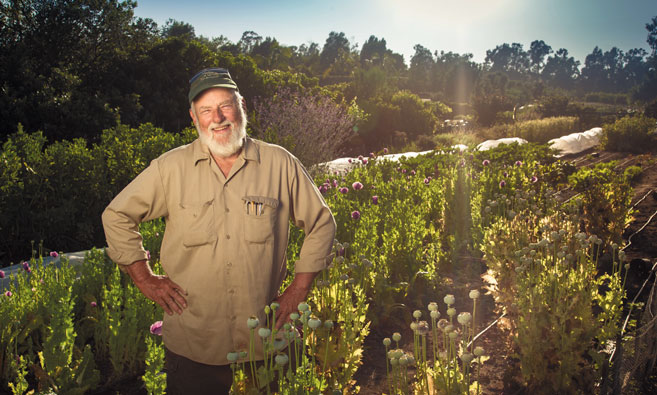A Mystic in Our Midst
Marshall Chrostowski carries authority benignly camouflaged with mirth. In the literature, humor is a signature of enlightenment, but Marshall has other qualities that qualify him as abnormally bright. He’ll self-efface in order to get your attention a little bit further down the line.
He’s my mentor, the guy I’ll give my turn to when he has something to say, somewhat professorial with not a hint of puffery. He’s impish, though sturdy, instinctively curious and patient, but outspoken when required. He knows a lot about what he knows but he doesn’t flaunt his ABD (All But Dissertation in biogeography-plant ecology-ethnobotany) from the University of Wisconsin, Madison, his precocious ethnobotany or his encyclopedic survey of the plant kingdom. After academia his experiences in the Amazon basin in the 1960s informed his lifelong passion for gardening, farming and the natural world.
He’s assured now by the glory of nature’s inspired details, the majesty of the miraculously created flora that is our honor to guard and obey, like the bees and seed-eating birds in the fall that seek out Maximilian sunflowers, and the monarch butterflies that depend on his seasonal sowing of milkweed. A pattern has been set. The birds, bees and butterflies make ready intuitively to take wing as soon as he gives the seed to the earth and tends the perennials, like the sunflower. Water is ordained.
As the sunflower opens, a bee zings into view. The mystic gardener knows his rows, plods the dewy dirt on alert for the new and expecting another subtle miracle to adore. Experience has created dedication and a life’s path. To admiringly acknowledge such subtle wonders is to revere them.
Saving seeds might as well be Marshall’s religion—he’s so ardent—but he thinks it’s hilarious to explain the practice so superficially. When people ask me why I save seeds I usually cut up, using religion as an excuse for doing something for so long I have forgotten why I do it. But Marshall’s robust and continual seed saving binds all his horticulture together, from seed to crop to seed, in a way that assures and promotes an acceptable, responsible result. This is no laughing matter. The plant’s gift to him is the seed, and his gift back to the plant is taking care of the seed. Together they will plant each other in the appropriate season to renew their relationship.
“When you have a handful of seed in your hands,” Marshall says, “you hold history and culture, the past, present and future. This simple fact is a crucial responsibility. What’s important in that moment is that you remember the story of that seed: where it came from recently, where it comes from in the past, why was it important then and why now?”
I formally interviewed Marshall recently, which is a surprising way to learn new information in depth professionally about a friend, detail that might not be revealed socially.
I had no idea there were so many reasons to esteem him.
As we talked, my memory drifted back, and I suddenly realized that my own seed-mania first struck when I visited him years ago at his house in the Samarkand district of Santa Barbara, a place bursting with elite plant journals and overburdened bookcases, with a vast tangle of various plants, mundane and exotic, flowering and setting seeds out in the back yard. That yard was a wall of potted foliage, carefully tagged and dated, some flowering, some dead and ready to be bagged.
This careful gardening was no hobby. His seed management was a political strategy, social and sacred activism. Rarely would any of us have imagined then how important these talents would prove now in an age of seed monopoly and vertical control of our human right to be seed sufficient. Back in that day, we were “merely” concerned that vast numbers of heirloom varieties were disappearing from regional seed catalogues. So we rescued them from oblivion. Marshall was an early supporter of the Seed Savers Exchange, the precursor of so many fabulous efforts now laboring to protect the genetic heritage of plants and their human guardians.
Marshall’s other principal work is designing gardens for people to give them what they want, and, after earnest instruction, what the rest of the world needs at the same time, like diversity. He serves as an ambassador from Leaf-Land, a diverse realm under severe attack, a spokesman and interpreter from a realm in need of better representation.
The plant kingdom is not loud but it is insistent. Marshall, hearing that call, arrives fully credentialed, and capable of diplomatically making certain that, as a rule, heirloom food crops subtly grace what might have been otherwise predictably austere and boring landscapes. He gives his clients an opportunity to cooperate in a crucial mission, to believe in, talk about and protect.
“It sure beats installing another boring row of bird of paradise flanked by Indian hawthorn,” he says.
In the many dozens of landscapes he has managed over five decades of beautification, each one is an island of genetic purity for the science of saving seed and plant material, simultaneously a method of assuring the future because all the seeds are not planted in one place. Saving seed integrates the power of centuries-old comprehension into our present functions.
Marshall was the perfect architect to design and install four special cultural and historical gardens at La Casa de Maria in Montecito, living dioramas depicting the spiritual and horticultural traditions of the Chumash Indians, Muslims, Jews and Buddhists.
As resident horticulturalist for more than two decades at the Pacifica Graduate Institute’s Lambert Road Campus in Summerland, Marshall has created and maintained an edible habitat for wildlife and humans. The harvested products are for the use of staff and students at the Institute. The seeds are Marshall’s, but they belong to everyone.





